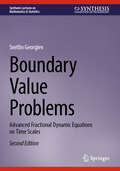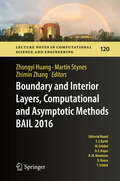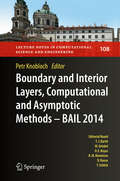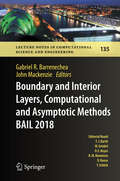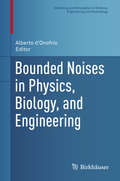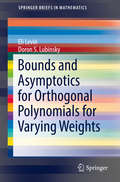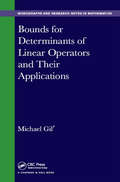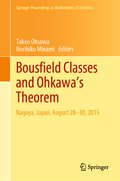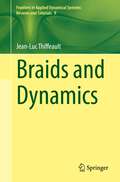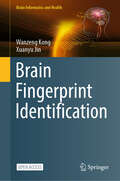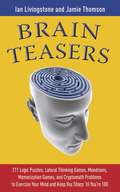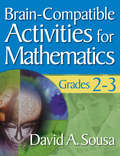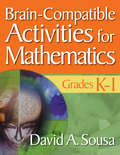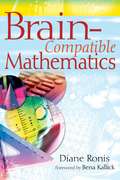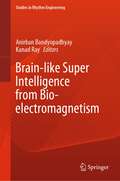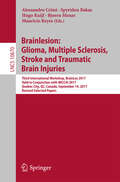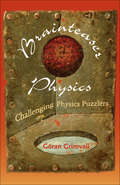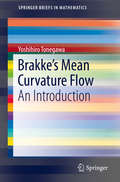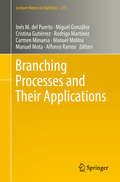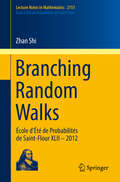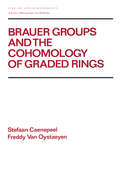- Table View
- List View
Boundary Value Problems: Advanced Fractional Dynamic Equations on Time Scales (Synthesis Lectures on Mathematics & Statistics)
by Svetlin GeorgievThis new edition presents an updated and expanded exploration of boundary value problems for fractional dynamic equations on arbitrary time scales, including Caputo fractional dynamic equations, impulsive Caputo fractional dynamic equations, and impulsive Riemann-Liouville fractional dynamic equations. In a new chapter, the author introduces time scale calculus and fractional time scale calculus. The book also covers initial value problems, boundary value problems, initial boundary value problems for each type of equation. The author provides integral representations of the solutions and proves the existence and uniqueness of the solutions. This second edition includes new and updated examples and problems.
Boundary and Interior Layers, Computational and Asymptotic Methods BAIL 2016 (Lecture Notes in Computational Science and Engineering #120)
by Zhongyi Huang Martin Stynes Zhimin ZhangThis volume collects papers associated with lectures that were presented at the BAIL 2016 conference, which was held from 14 to 19 August 2016 at Beijing Computational Science Research Center and Tsinghua University in Beijing, China. It showcases the variety and quality of current research into numerical and asymptotic methods for theoretical and practical problems whose solutions involve layer phenomena. The BAIL (Boundary And Interior Layers) conferences, held usually in even-numbered years, bring together mathematicians and engineers/physicists whose research involves layer phenomena, with the aim of promoting interaction between these often-separate disciplines. These layers appear as solutions of singularly perturbed differential equations of various types, and are common in physical problems, most notably in fluid dynamics. This book is of interest for current researchers from mathematics, engineering and physics whose work involves the accurate app roximation of solutions of singularly perturbed differential equations; that is, problems whose solutions exhibit boundary and/or interior layers.
Boundary and Interior Layers, Computational and Asymptotic Methods - BAIL 2014 (Lecture Notes in Computational Science and Engineering #108)
by Petr KnoblochThis volume offers contributions reflecting a selection of the lectures presented at the international conference BAIL 2014, which was held from 15th to 19th September 2014 at the Charles University in Prague, Czech Republic. These are devoted to the theoretical and/or numerical analysis of problems involving boundary and interior layers and methods for solving these problems numerically. The authors are both mathematicians (pure and applied) and engineers, and bring together a large number of interesting ideas. The wide variety of topics treated in the contributions provides an excellent overview of current research into the theory and numerical solution of problems involving boundary and interior layers.
Boundary and Interior Layers, Computational and Asymptotic Methods BAIL 2018 (Lecture Notes in Computational Science and Engineering #135)
by Gabriel R. Barrenechea John MackenzieThis volume gathers papers presented at the international conference BAIL, which was held at the University of Strathclyde, Scotland from the 14th to the 22nd of June 2018. The conference gathered specialists in the asymptotic and numerical analysis of problems which exhibit layers and interfaces. Covering a wide range of topics and sharing a wealth of insights, the papers in this volume provide an overview of the latest research into the theory and numerical approximation of problems involving boundary and interior layers.
Bounded Gaps Between Primes: The Epic Breakthroughs of the Early Twenty-First Century
by Kevin BroughanSearching for small gaps between consecutive primes is one way to approach the twin primes conjecture, one of the most celebrated unsolved problems in number theory. This book documents the remarkable developments of recent decades, whereby an upper bound on the known gap length between infinite numbers of consecutive primes has been reduced to a tractable finite size. The text is both introductory and complete: the detailed way in which results are proved is fully set out and plenty of background material is included. The reader journeys from selected historical theorems to the latest best result, exploring the contributions of a vast array of mathematicians, including Bombieri, Goldston, Motohashi, Pintz, Yildirim, Zhang, Maynard, Tao and Polymath8. The book is supported by a linked and freely-available package of computer programs. The material is suitable for graduate students and of interest to any mathematician curious about recent breakthroughs in the field.
Bounded Noises in Physics, Biology, and Engineering (Modeling and Simulation in Science, Engineering and Technology)
by Alberto D'OnofrioSince the parameters in dynamical systems of biological interest are inherently positive and bounded, bounded noises are a natural way to model the realistic stochastic fluctuations of a biological system that are caused by its interaction with the external world. Bounded Noises in Physics, Biology, and Engineering is the first contributed volume devoted to the modeling of bounded noises in theoretical and applied statistical mechanics, quantitative biology, and mathematical physics. It gives an overview of the current state-of-the-art and is intended to stimulate further research. The volume is organized in four parts. The first part presents the main kinds of bounded noises and their applications in theoretical physics. The theory of bounded stochastic processes is intimately linked to its applications to mathematical and statistical physics, and it would be difficult and unnatural to separate the theory from its physical applications. The second is devoted to framing bounded noises in the theory of random dynamical systems and random bifurcations, while the third is devoted to applications of bounded stochastic processes in biology, one of the major areas of potential applications of this subject. The final part concerns the application of bounded stochastic processes in mechanical and structural engineering, the area where the renewed interest for non-Gaussian bounded noises started. Pure mathematicians working on stochastic calculus will find here a rich source of problems that are challenging from the point of view of contemporary nonlinear analysis. Bounded Noises in Physics, Biology, and Engineering is intended for scientists working on stochastic processes with an interest in both fundamental issues and applications. It will appeal to a broad range of applied mathematicians, mathematical biologists, physicists, engineers, and researchers in other fields interested in complexity theory. It is accessible to anyone with a working knowledge of stochastic modeling, from advanced undergraduates to senior researchers.
Bounds and Asymptotics for Orthogonal Polynomials for Varying Weights
by Eli Levin Doron S. LubinskyThis book establishes bounds and asymptotics under almost minimal conditions on the varying weights, and applies them to universality limits and entropy integrals. Orthogonal polynomials associated with varying weights play a key role in analyzing random matrices and other topics. This book will be of use to a wide community of mathematicians, physicists, and statisticians dealing with techniques of potential theory, orthogonal polynomials, approximation theory, as well as random matrices.
Bounds for Determinants of Linear Operators and their Applications (Chapman & Hall/CRC Monographs and Research Notes in Mathematics)
by Michael Gil'This book deals with the determinants of linear operators in Euclidean, Hilbert and Banach spaces. Determinants of operators give us an important tool for solving linear equations and invertibility conditions for linear operators, enable us to describe the spectra, to evaluate the multiplicities of eigenvalues, etc. We derive upper and lower bounds, and perturbation results for determinants, and discuss applications of our theoretical results to spectrum perturbations, matrix equations, two parameter eigenvalue problems, as well as to differential, difference and functional-differential equations.
Bousfield Classes and Ohkawa's Theorem: Nagoya, Japan, August 28-30, 2015 (Springer Proceedings in Mathematics & Statistics #309)
by Takeo Ohsawa Norihiko MinamiThis volume originated in the workshop held at Nagoya University, August 28–30, 2015, focusing on the surprising and mysterious Ohkawa's theorem: the Bousfield classes in the stable homotopy category SH form a set. An inspiring, extensive mathematical story can be narrated starting with Ohkawa's theorem, evolving naturally with a chain of motivational questions: Ohkawa's theorem states that the Bousfield classes of the stable homotopy category SH surprisingly forms a set, which is still very mysterious. Are there any toy models where analogous Bousfield classes form a set with a clear meaning?The fundamental theorem of Hopkins, Neeman, Thomason, and others states that the analogue of the Bousfield classes in the derived category of quasi-coherent sheaves Dqc(X) form a set with a clear algebro-geometric description. However, Hopkins was actually motivated not by Ohkawa's theorem but by his own theorem with Smith in the triangulated subcategory SHc, consisting of compact objects in SH. Now the following questions naturally occur: (1) Having theorems of Ohkawa and Hopkins-Smith in SH, are there analogues for the Morel-Voevodsky A1-stable homotopy category SH(k), which subsumes SH when k is a subfield of C?, (2) Was it not natural for Hopkins to have considered Dqc(X)c instead of Dqc(X)? However, whereas there is a conceptually simple algebro-geometrical interpretation Dqc(X)c = Dperf(X), it is its close relative Dbcoh(X) that traditionally, ever since Oka and Cartan, has been intensively studied because of its rich geometric and physical information.This book contains developments for the rest of the story and much more, including the chromatics homotopy theory, which the Hopkins–Smith theorem is based upon, and applications of Lurie's higher algebra, all by distinguished contributors.
Bracelets for Bina's Brothers (Storytelling Math)
by Rajani LaRoccaCelebrate diversity, math, and the power of storytelling!For the Hindu holiday of Raksha Bandhan, Bina is determined to make beaded bracelets for her brothers all by herself. She finds out which colors her brothers like and dislike and sets to work. Working with her every-other-one beading pattern causes Bina to discover something new about patterns--and her brothers.Storytelling Math celebrates children using math in their daily adventures as they play, build, and discover the world around them. Joyful stories and hands-on activities make it easy for kids and their grown-ups to explore everyday math together. Developed in collaboration with math experts at STEM education nonprofit TERC, under a grant from the Heising-Simons Foundation.
Braids and Dynamics (Frontiers in Applied Dynamical Systems: Reviews and Tutorials #9)
by Jean-Luc ThiffeaultThis monograph uses braids to explore dynamics on surfaces, with an eye towards applications to mixing in fluids. The text uses the particular example of taffy pulling devices to represent pseudo-Anosov maps in practice. In addition, its final chapters also briefly discuss current applications in the emerging field of analyzing braids created from trajectory data. While written with beginning graduate students, advanced undergraduates, or practicing applied mathematicians in mind, the book is also suitable for pure mathematicians seeking real-world examples. Readers can benefit from some knowledge of homotopy and homology groups, but these concepts are briefly reviewed. Some familiarity with Matlab is also helpful for the computational examples.
Brain Fingerprint Identification (Brain Informatics and Health)
by Wanzeng Kong Xuanyu JinThis open access book delves into the emerging field of biometric identification using brainwave patterns. Specifically, this book presents recent advances in electroencephalography (EEG)-based biometric recognition to identify unique neural signatures that can be used for secure authentication and identification. Traditional biometric systems such as fingerprints, iris scans, and face recognition have become integral to security and identification. However, these methods are increasingly vulnerable to spoofing and other forms of attack. Unlike other traditional biometrics, EEG signals are non-invasive, continuous authentication, liveness detection, and resistance to coercion due to the complexity and uniqueness of brain patterns. Therefore, it is particularly suitable for high-security fields such as military and finance, providing a promising alternative for future high-security identification and authentication. However, most of the existing brain fingerprint identification studies require subjects to perform specific cognitive tasks, which limits the popularization and application of brain fingerprint identification in practical scenarios. Additionally, due to the low signal-to-noise ratio (SNR) and time-varying characteristics of EEG signals, there are distribution differences in EEG data across sessions from several days, leading to stability issues in brain fingerprint features extracted at different sessions. Finally, because the EEG signal is affected by the coupling of multiple factors and the nervous system has continuous spontaneous variability, which makes it difficult for the brain fingerprint identification model to be suitable for the scenarios of unseen sessions and cognitive tasks, and there is the problem of insufficient model generalization. In this book, based on traditional machine learning methods and deep learning methods, the authors will carry out multi-task single-session, single-task multi-session, and multi-task multi-session brain fingerprint identification research respectively for the above problems, to provide an effective solution for the application of brain fingerprint identification in practical scenarios.
Brain Network Analysis
by Moo K. ChungThis tutorial reference serves as a coherent overview of various statistical and mathematical approaches used in brain network analysis, where modeling the complex structures and functions of the human brain often poses many unique computational and statistical challenges. This book fills a gap as a textbook for graduate students while simultaneously articulating important and technically challenging topics. Whereas most available books are graph theory-centric, this text introduces techniques arising from graph theory and expands to include other different models in its discussion on network science, regression, and algebraic topology. Links are included to the sample data and codes used in generating the book's results and figures, helping to empower methodological understanding in a manner immediately usable to both researchers and students.
Brain Teasers
by Jamie Thomson Ian LivingstoneA great way to have fun and build brain power, Brain Teasers offers a variety of games to delight and challenge even the most advanced puzzler. Brain Teasers shows off some outrageously fun new mindbenders, like anasearches (a combination of an anagram, a crossword, and a word search), numberlockers (think of a crossword puzzle with numbers instead of words), and alphabetics (a miniature crossword puzzle that uses each letter of the alphabet exactly once). Perfect for anyone who sits down with the New York Times crossword puzzle every morning or works through Sudoku puzzles on the way home, this book is guaranteed to excite your mind and jump-start your brain.
Brain-Compatible Activities for Mathematics, Grades 2-3
by Dr David A. SousaAligned with NCTM standards and focal points, this resource offers ready-to-use lessons that include brain-compatible math activities, step-by-step instructions for the teacher, and all the necessary reproducibles.
Brain-Compatible Activities for Mathematics, Grades K-1
by Dr David A. SousaAligned with NCTM standards and focal points, this resource offers ready-to-use lessons that include brain-compatible math activities, step-by-step instructions for the teacher, and all the necessary reproducibles.
Brain-Compatible Mathematics
by Diane RonisStudents’ brains are wired to make them natural, curious learners. The mathematical world around them offers a vast classroom, filled with shapes, spaces, quantities, and experiences to discover and explore, all leading to the construction of understanding. Teachers can use this natural curiosity to tap the inborn neural mechanisms that motivate students to learn--to make relevance and meaning of their surroundings. Brain-Compatible Mathematics, Second Edition bridges the findings from the realms of brain research and improved mathematics instruction through updated teaching samples, connections to the most recent standards, newest research findings, and integration to other content areas. Each brain is different, and when teachers teach problem-solving skills to help students arrive at their own solution paths, students go beyond mere memorization of facts and algorithms to being an actual participant in the development of mathematical understanding. In an informative and relevant approach, Diane Ronis presents teachers and math leaders with an emphasis on thinking, mathematical representation, and construction of ideas and an abundance of: Sample lessons, units, and strategies linked to 2000 NCTM standards Brain-friendly strategies for math teaching that meet NCLB requirements How-to guides for creating more brain-tuned math teaching Ideas for incorporating technology into the math curriculum Planning templates for immediate use By integrating math learning into real-world applications, students can actively practice what they learn, make meaning out of their everyday experiences, and think mathematically for success within today’s information age.
Brain-like Super Intelligence from Bio-electromagnetism (Studies in Rhythm Engineering)
by Kanad Ray Anirban BandyopadhyayThis book discusses various aspects of bioinspired technologies but with an additional emphasis on the medical science, starting from the popular article on neurobiology to pure biophysics that ends with the superintelligence of biological systems that could be reverse engineered. It covers eight different aspects of natural intelligence, starting from the fundamental electromagnetic properties of a protein to the vibrations and the resonance of the entire biomaterial system. It also covers a wide spectrum of hierarchical communication among different biological systems for intelligence and then medical science is applied.
Brainlesion: Glioma, Multiple Sclerosis, Stroke and Traumatic Brain Injuries
by Bjoern Menze Alessandro Crimi Mauricio Reyes Spyridon Bakas Hugo KuijfThis book constitutes revised selected papers from the Third International MICCAI Brainlesion Workshop, BrainLes 2017, as well as the International Multimodal Brain Tumor Segmentation, BraTS, and White Matter Hyperintensities, WMH, segmentation challenges, which were held jointly at the Medical Image computing for Computer Assisted Intervention Conference, MICCAI, in Quebec City, Canada, in September 2017. The 40 papers presented in this volume were carefully reviewed and selected from 46 submissions. They were organized in topical sections named: brain lesion image analysis; brain tumor image segmentation; and ischemic stroke lesion image segmentation.
Brainteaser Physics: Challenging Physics Puzzlers
by Göran GrimvallDoes a glass of ice water filled to the brim overflow when the ice melts? Does the energy inside a sauna increase when you heat it up? What's the best way to cool your coffee—adding the creamer first or last? These and other challenging puzzlers provide a fresh—and fun—approach to learning real physics. Presenting both classic and new problems, Brainteaser Physics challenges readers to use imagination and basic physics principles to find the answers. Göran Grimvall provides detailed and accessible explanations of the solutions, sometimes correcting the standard explanations, sometimes putting a new twist on them. He provides diagrams and equations where appropriate and ends each problem by discussing a specific concept or offering an extra challenge.With Brainteaser Physics, students and veteran physicists alike can sharpen their critical and creative thinking—and have fun at the same time.
Brainteaser für Anfänger und Fortgeschrittene: 220 Aufgaben mit Lösungen für Gehirnjogging und Logik-Skills
by Yevgen LantsuzovskyyWer seine Konzentration und Auffassungsgabe verbessern will, liegt mit diesem Buch genau richtig. Die vielen praktischen und interaktiven Aufgaben helfen dabei, die Problemlösekompetenz gezielt zu trainieren. Das Buch richtet sich an alle, die Spaß am Lösen herausfordernder Aufgaben haben oder sich auf ein Auswahlgespräch in einem Job-Bewerbungsverfahren vorbereiten möchten. Zu Beginn des Buches finden Sie zehn Brainteaser zum Aufwärmen. Danach werden die theoretischen Grundlagen vermittelt, gefolgt von zahlreichen praktischen Aufgaben aus verschiedenen Brainteaser-Kategorien mit unterschiedlichen Schwierigkeitsgraden. Am Ende können die Leserinnen und Leser ihr gesammeltes Wissen in drei Beispieltests à zehn Aufgaben auf die Probe stellen. Zu jedem Brainteaser gibt es ausführliche und nachvollziehbare Lösungshinweise. Für die zweite Auflage wurde der Inhalt überarbeitet und erweitert. Einzelne Übungsaufgaben sind auch in der Springer Nature Flashcards App abrufbar.Der InhaltLösungsstrategien für BrainteaserMathematisch-analytische AufgabenFang-, Schätz- und Dilemma-FragenDetektiv-Rätsel und grafische ChallengesLösung zu jeder Aufgabe und jedem Probetest
Brakke's Mean Curvature Flow: An Introduction (SpringerBriefs in Mathematics)
by Yoshihiro TonegawaThis book explains the notion of Brakke’s mean curvature flow and its existence and regularity theories without assuming familiarity with geometric measure theory. The focus of study is a time-parameterized family of k-dimensional surfaces in the n-dimensional Euclidean space (1 ≤ k n). The family is the mean curvature flow if the velocity of motion of surfaces is given by the mean curvature at each point and time. It is one of the simplest and most important geometric evolution problems with a strong connection to minimal surface theory. In fact, equilibrium of mean curvature flow corresponds precisely to minimal surface. Brakke’s mean curvature flow was first introduced in 1978 as a mathematical model describing the motion of grain boundaries in an annealing pure metal. The grain boundaries move by the mean curvature flow while retaining singularities such as triple junction points. By using a notion of generalized surface called a varifold from geometric measure theory which allows the presence of singularities, Brakke successfully gave it a definition and presented its existence and regularity theories. Recently, the author provided a complete proof of Brakke’s existence and regularity theorems, which form the content of the latter half of the book. The regularity theorem is also a natural generalization of Allard’s regularity theorem, which is a fundamental regularity result for minimal surfaces and for surfaces with bounded mean curvature. By carefully presenting a minimal amount of mathematical tools, often only with intuitive explanation, this book serves as a good starting point for the study of this fascinating object as well as a comprehensive introduction to other important notions from geometric measure theory.
Branching Processes and Their Applications (Lecture Notes in Statistics #219)
by Inés M. del Puerto Miguel González Cristina Gutiérrez Rodrigo Martínez Carmen Minuesa Manuel Molina Manuel Mota Alfonso RamosThis volume gathers papers originally presented at the 3rd Workshop on Branching Processes and their Applications (WBPA15), which was held from 7 to 10 April 2015 in Badajoz, Spain (http://branching. unex. es/wbpa15/index. htm). The papers address a broad range of theoretical and practical aspects of branching process theory. Further, they amply demonstrate that the theoretical research in this area remains vital and topical, as well as the relevance of branching concepts in the development of theoretical approaches to solving new problems in applied fields such as Epidemiology, Biology, Genetics, and, of course, Population Dynamics. The topics covered can broadly be classified into the following areas: 1. Coalescent Branching Processes 2. Branching Random Walks 3. Population Growth Models in Varying and Random Environments 4. Size/Density/Resource-Dependent Branching Models 5. Age-Dependent Branching Models 6. Special Branching Models 7. Applications in Epidemiology 8. Applications in Biology and Genetics Offering a valuable reference guide to contemporary branching process theory, the book also explores many open problems, paving the way for future research.
Branching Random Walks: École d'Été de Probabilités de Saint-Flour XLII – 2012 (Lecture Notes in Mathematics #2151)
by Zhan ShiProviding an elementary introduction to branching random walks, the main focus of these lecture notes is on the asymptotic properties of one-dimensional discrete-time supercritical branching random walks, and in particular, on extreme positions in each generation, as well as the evolution of these positions over time. Starting with the simple case of Galton-Watson trees, the text primarily concentrates on exploiting, in various contexts, the spinal structure of branching random walks. The notes end with some applications to biased random walks on trees.
Brauer Groups and the Cohomology of Graded Rings
by Stefaan CaenepeelThis book introduces various notions defined in graded terms extending the notions most frequently used as basic ingredients in the theory of Azumaya algebras: separability and Galois extensions of commutative rings, crossed products and Galois cohomology, Picard groups, and the Brauer group.
